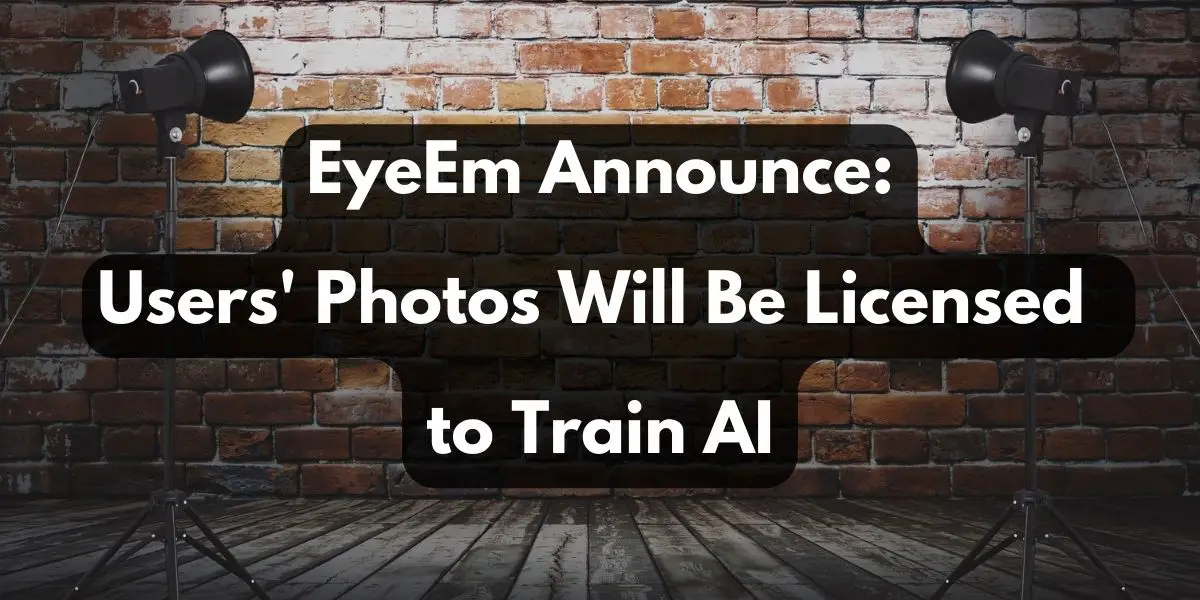EyeEm Announce: Users' Photos Will Be Licensed to Train AI

The world of digital photography is ever-evolving, and EyeEm, a renowned photo-sharing platform, has taken a controversial step by licensing users’ photos to train AI models. This decision has sparked varied reactions and raised important questions about the role of user-generated content in advancing technology.
EyeEm has introduced a new policy to license users’ photos for AI training, sparking debate over technology’s impact on user-generated content. The policy provides new features for the platform, yet raises concerns about data ownership and privacy.
Table of Contents
What is EyeEm?

EyeEm is a global photo-sharing platform that brings together photographers, enthusiasts, and professionals. Since its inception in 2011, it has cultivated a vibrant community, offering a space to share, collaborate, and participate in photography competitions. EyeEm’s marketplace also allows users to sell their photos, bridging the gap between amateur and professional photographers.
The platform’s tools empower users to improve their skills, expand their creativity, and connect with others. EyeEm’s partnerships with industry players offer users opportunities ranging from licensing deals to showcasing their work in exhibitions, contributing to its growth as a key player in digital photography.
What Is EyeEm's New Policy?
BeFake AI and BeReal, at first glance, might seem like two peas in a pod. Both are social networking apps, and both revolve around photo sharing. However, that’s where the similarities end. BeReal emphasizes capturing and sharing authentic moments in real-time. It’s about the here and now, the raw and unfiltered. BeFake AI, on the other hand, takes a different approach. While it also allows users to snap photos, it encourages them to use AI technology to customize and augment these images. The name “BeFake” itself is a playful nod to its counterpart, suggesting that instead of real-time authenticity, it’s about showcasing one’s creative flair and imagination.
Also read: Google and OpenAI Use YouTube Data to Train Their AI Model
Why does EyeEm license Users’ photos to train AI?
EyeEm’s decision to license users’ photos for AI training stems from several key reasons:
- Technological Advancement: EyeEm aims to integrate AI into its platform, offering features like automated tagging, improved content recommendations, and enhanced search capabilities.
- Competitive Edge: By leveraging AI, EyeEm seeks to remain relevant and competitive in the digital photography market, distinguishing itself from other platforms.
- Collaborations: The integration of AI opens doors for EyeEm to collaborate with AI developers and tech companies, fostering innovation and expanding its reach.
- User Experience: Improved AI capabilities can provide a seamless and intuitive experience for EyeEm’s users, increasing engagement and community growth.
Impact that EyeEm brings to users
EyeEm’s new policy brings both positive and negative implications for its users:
- Enhanced Features: Users can benefit from AI-driven features, such as automated tagging and smarter content recommendations.
- Increased Exposure: Licensed photos could reach new markets, potentially boosting photographers’ visibility and opportunities.
- Data Ownership: Users express concerns about losing control over their photos, emphasizing the need for clearer policies.
- Trust Issues: The policy’s ambiguity has caused unease among users, potentially affecting their relationship with EyeEm.
Users react towards EyeEm license photos
The introduction of EyeEm’s new policy allowing users’ photos to be licensed for AI training has generated varied reactions from its community. While some users see it as a step towards technological advancement, others express concerns about its implications.
Technological Advancement
A segment of EyeEm’s community views the integration of AI as a positive development. These users appreciate the potential for new features, such as automated tagging and content recommendations, which can enhance the platform’s functionality. This group also sees EyeEm’s policy as a strategic move, helping the company stay competitive in the digital photography industry and benefiting both the platform and its users.
Data Ownership and Privacy
Conversely, many users have expressed concerns about data ownership and privacy. The policy’s perceived ambiguity raises fears of losing control over their photos. Some users worry about how their photos might be used for AI training, particularly regarding personal data and the connection between photos and other information. This unease has led to calls for clearer policies and guidelines.
Transparency and Trust
The mixed response to EyeEm’s policy highlights the delicate balance between technological progress and maintaining user trust. The lack of transparency regarding how EyeEm will utilize users’ photos has fueled debate, leading to demands for more explicit policies. Addressing these concerns is crucial for sustaining EyeEm’s community’s confidence and ensuring its continued growth.
Also read: Explicit AI Photos of Paige Bueckers: Confronting Digital Violations
Concerns raised behind EyeEm licensed Users’ Photos
EyeEm’s new policy has raised several key concerns:
- Data Ownership: Users fear losing control over their photos once they are licensed, questioning their rights to their content.
- Privacy: The potential connection between personal information and photos used for AI training has sparked apprehension.
- Misuse: Critics argue that licensed photos could be exploited in unintended or unethical ways, including in controversial AI models.
- Transparency: Users demand clearer policies from EyeEm, emphasizing the need for explicit guidelines on how their photos will be used.
- Community Trust: The lack of transparency and potential misuse of photos threaten to erode trust between EyeEm and its users, potentially affecting the platform’s growth.
Also read: The Taylor Swift AI Outrage: Fans Rally Against Deepfake Dilemma
Legal Implications behind EyeEm's New Policy
The new policy also brings about significant legal considerations:
- Copyright Infringement: Users worry about potential violations if their photos are licensed without explicit permission.
- Liability: EyeEm may face legal challenges if third-party AI models misuse users’ photos, leading to lawsuits or reputational damage.
- Terms of Service: The need for clearer terms is emphasized to prevent ambiguity, protect users’ rights, and safeguard EyeEm’s interests.
- Jurisdictional Issues: Varied laws across countries may lead to conflicts, affecting how EyeEm implements its policy globally.
- Ethical Considerations: The policy raises ethical questions regarding the use of user-generated content in AI training, particularly in cases where it might conflict with users’ rights or interests.
What are EyeEm's Future Plans?

EyeEm is set to continue its growth trajectory, focusing on advancing its platform’s technological capabilities and strengthening its community. Key elements of EyeEm’s future plans include:
- Technological Integration: EyeEm aims to enhance its AI-driven features, including automated tagging, improved content recommendations, and enhanced search functionality, providing a seamless user experience.
- Partnerships: EyeEm seeks to collaborate with AI developers and tech companies, exploring new opportunities for innovation and expanding its reach in the digital photography industry.
- Community Engagement: The platform is exploring ways to increase user engagement, such as by fostering trust through transparent policies, clear terms of service, and open communication.
- Market Position: EyeEm intends to solidify its position in the digital photography market, integrating advanced technologies to differentiate itself from competitors and attract new users.
Conclusion
EyeEm’s new policy has brought to light the complex relationship between user-generated content and technological advancement. While AI integration offers new features and opportunities for the platform, it has also sparked debate over data ownership, privacy, and ethical considerations. EyeEm’s ability to balance these concerns with its growth strategy is crucial, as it seeks to enhance its platform, build user trust, and stay competitive in the digital photography industry. The path forward for EyeEm involves navigating these challenges while continuing to offer value to its community, marking a significant turning point for both the company and its users.

